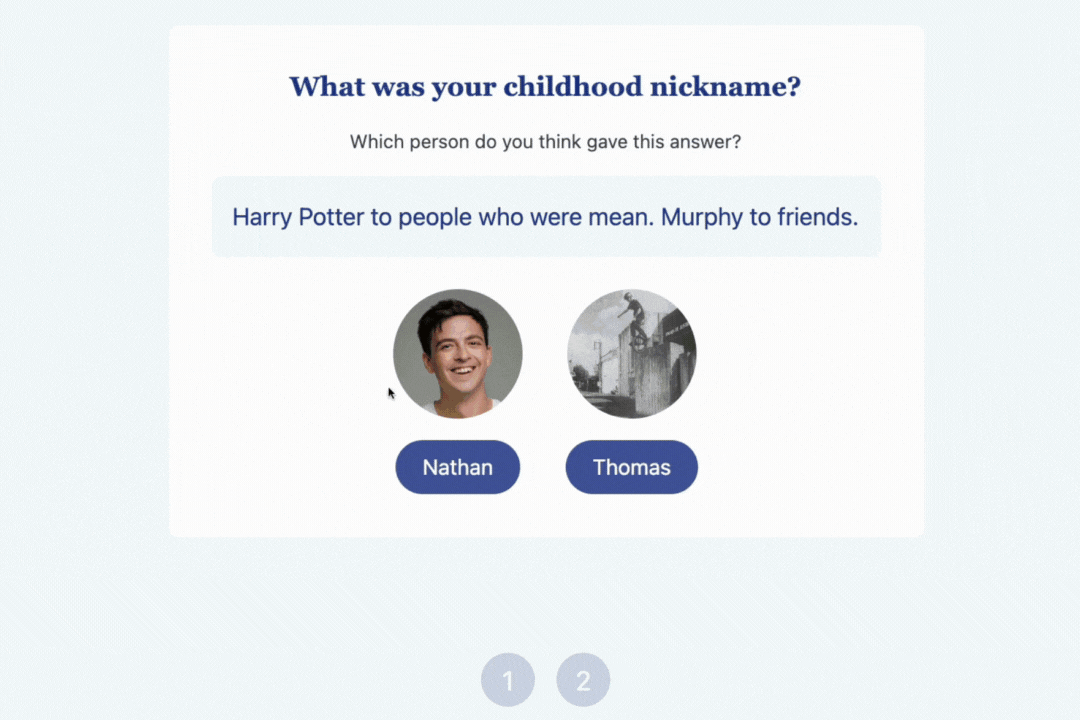In this chapter, we'll take you through some great icebreaker games for team meetings.
These icebreaker activities are a great way to engage remote teams and new hires as well, create a better company culture, strengthen trust towards the next person in the team, and so on. They're also great breakers for training sessions, meetings training seminars, and other events.
Any successful business leader will understand the importance of running engaging, motivational and informative team meetings.
Fairly recent research has also highlighted the importance of running effective team meetings to produce positive outcomes for both the team and the organisation.
Based on this, we cannot recommend highly enough that you incorporate fun team icebreakers into your meetings to lighten the mood and energise co workers and teams, especially as meetings can be a bit dry.
| Icebreaker | Participants | Duration | Difficulty |
|---|---|---|---|
| 1. Trivia Games | 3 - 200 people | 10 - 15 mins | Medium |
| 2. High Note | 20 to 50 people | 20 mins | Medium |
| 3. Piece By Piece | 8 - 40 people | 15 - 20 mins | High |
| 4. Star Light, Star Bright | 6 - 18 people | 6 - 8 mins | Medium |
| 5. Simon Sez | 10 - 200 people | 5 mins | Medium |
| 6. Birth Right | 15 - 50 people | 5 - 7 mins | High |
| 7. Double Take | 20 - 500 people | 3 - 5 mins | High |
| 8. Great Shake | 20 - 250 people | 2 - 4 mins | High |
| 9. Hand Jive | 20 - 60 people | 8 - 10 mins | Medium |
| 10. Traffic Noise | 20 - 60 people | 8 - 10 mins | Medium |
How To Run Better Icebreaker Meetings
Actually, we built our own ice breaker game perfect for meetings and I'd love to share it with you.
Leaders at companies including the NYTimes, Google & Coca Cola are using QuizBreaker as a fun way, automated way to bring a bit more fun into team meetings each week.
Learn more about QuizBreaker & try it for free.
If your team is working remotely at the moment then you should check out our guide on virtual team-building activities and games for remote teams. In there you'll find 100 ice breaker ideas with instructions that you can try with your newly remote team.
Apart from icebreaker questions, you can run other games and activities like:
-
Trivia games;
-
Pulse surveys;
-
Work personality tests;
-
Work preference and styles discussions;
-
And more.
So, here you go; here's our favorite icebreakers for you and your team to use in the next meeting or team get-together...
Our Top Ten Icebreaker Games for Meetings
Let's dive in and take a look at the top ten icebreaker games that you can use during meetings. Here are our picks:
1. Trivia Games
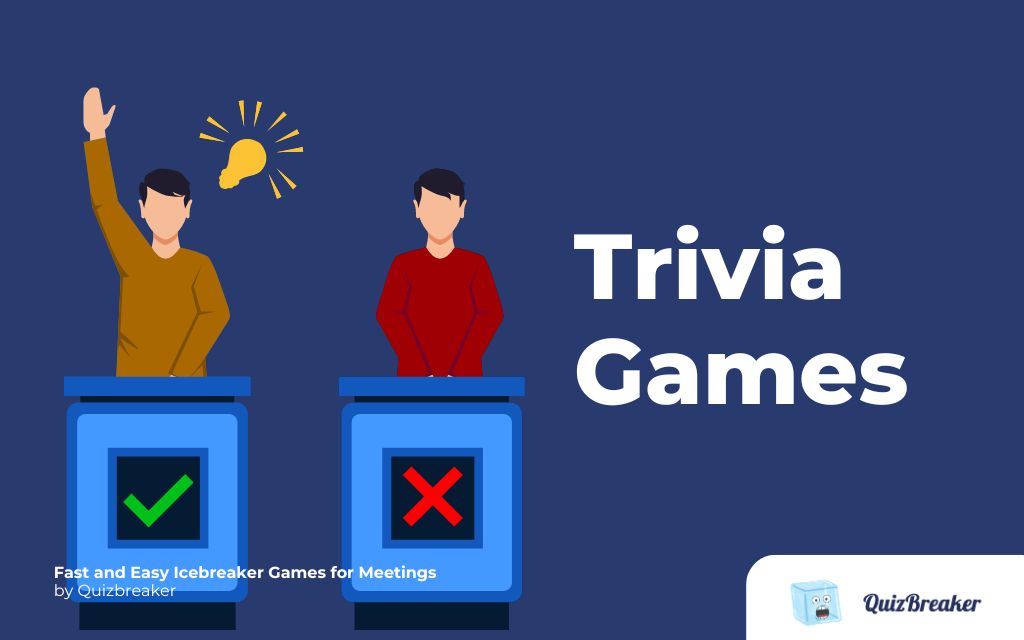
Objective: To get people's brains running before a meeting
Participants: 3 to 200 people
Duration: 10 to 15 minutes
Difficulty: Medium
Materials: A trivia tool like TriviaNerd
Who doesn't like a good trivia challenge before a meeting? Not only is it a fun icebreaker game perfect for team bonding or meetings. It gets your juices flowing and everyone hyped up with some of the best ideas and ready to answer some problems.
We love trivia games because they're easy to run and never get old, plus you learn some interesting facts in the process.
There are gazillions of trivia questions to choose from, and you can do them before any meeting. Hey, why not even throw in a quick trivia break in the middle of your brainstorm?
Instructions
-
Choose trivia questions.
-
Have your meeting attendees answer questions. Whoever gets the most correct answers the fastest wins.
It's that easy! This classic game for ice breakers could also get much easier with a tool like TriviaNerd, which has over 100,000 trivia questions in its database and a nice multiplayer interface that makes trivia challenges more exciting.
Because it's an online tool, it's also great for virtual icebreakers. You can use TriviaNerd for Zoom meetings and break the ice while learning fun facts in the process.
2. High Note
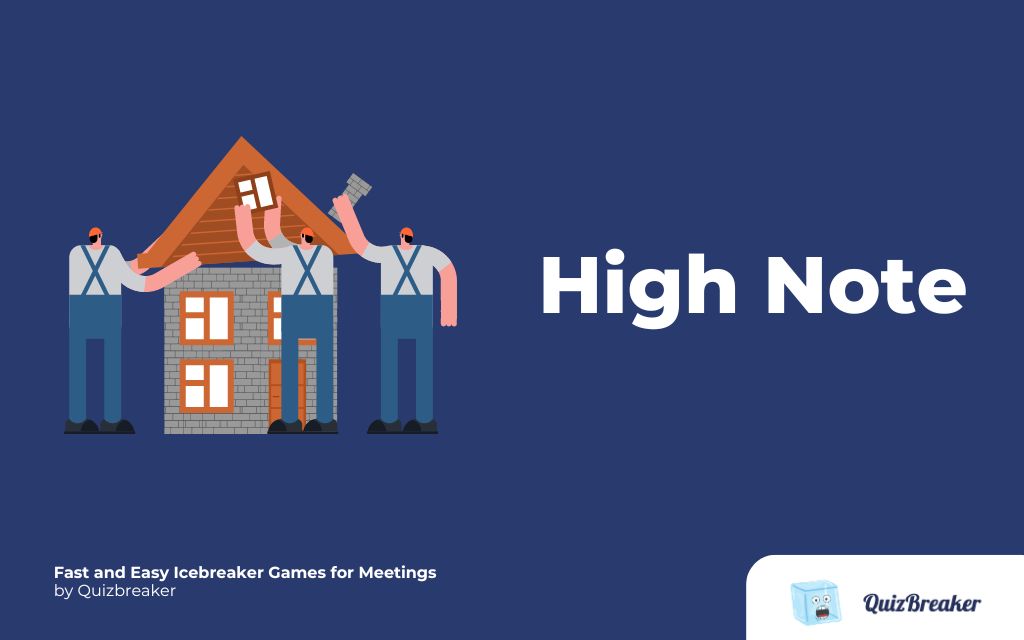
Objective: To get the employees to build a certain object within a time frame
Participants: 20 to 50 people
Duration: 20 minutes
Difficulty: Medium
Materials: Items of your choice to turn into objects (e.g., paper, marshmallows, straws)
This ice breaker promotes creativity, which empirical studies have found influences positive team outcomes.
Based on this, we cannot recommend using this icebreaker enough during a meeting to increase the likelihood of positive team outcomes!
Building challenges are also problem-solving focused, a skill that enhances team decision making, and thus team effectiveness.
Instructions
There are many variations of the building challenge ice breakers, but they all follow a pattern similar to this:
-
Divide employees into small teams, we suggest no more than six per team. It would be helpful to have a group leader.
-
Decide on what you want them to build with the unconventional material (e.g., who can build the tallest free standing tower from paper, who can create the London eye from straws).
-
With this, decide if they are allowed any other materials. For example, in the paper tower challenge, you may want to allow the teams to use sellotape to stick the paper together. Whereas the marshmallow challenge involves giving each group some dried spaghetti, string, tape and a marshmallow and groups have to build the tallest structure possible with the marshmallow on top.
-
Set a time limit, we suggest no longer than five minutes.
-
After the five minutes is up, get the teams to step away from their creation and decide who’s is the best (based on appearance, height, ability to stand on its own).
3. Piece By Piece
.jpg)
Objective: To get everyone working together to solve a puzzle in a certain time
Participants: 8 to 40 people
Duration: 15 to 20 minutes
Difficulty: High
Materials: One 50-piece puzzle and 4 small bags per group of four
We love this ice breaker activity because it’s focus is on engaging all team members.
Personally, we think engaging all team members during meetings is super important because research has found that employees who are more engaged, perform better.
As one of the most fun icebreakers out there, it can be used at any time, but whenever you decide to use it, make sure you make a point about interdependence, the necessity of having everyone’s input and the importance of regular communication.
It's perfect for both small groups and large groups.
Instructions
-
Organise your team into groups of four.
-
Divide the pieces from each puzzle into the four bags.
-
Put one complete puzzle (which is separated into the four bags) on each table.
-
Each participant in the team must take a bag.
-
Tell participants that they have to follow these instructions when putting together puzzle:
-
For the first two minutes, they should begin putting their puzzle pieces together by alternating turns. This should be done without talking or touching one another's pieces.
-
After two minutes, they should continue taking turns putting down pieces in silence, but they can touch each other pieces.
-
Finally, they have 5 minutes to finish putting the puzzle together in any way they like.
-
At the end, ask participants for observations and insights they gained from the activity.
Whilst you're here, check at our awesome online quiz game perfect for team meetings: QuizBreaker.
Thousands of teams around the world play QuizBreaker as a fun way to learn more about each other and bring their teams closer together each week.
Click here to learn more about QuizBreaker and try it for free.
4. Star Light, Star Bright
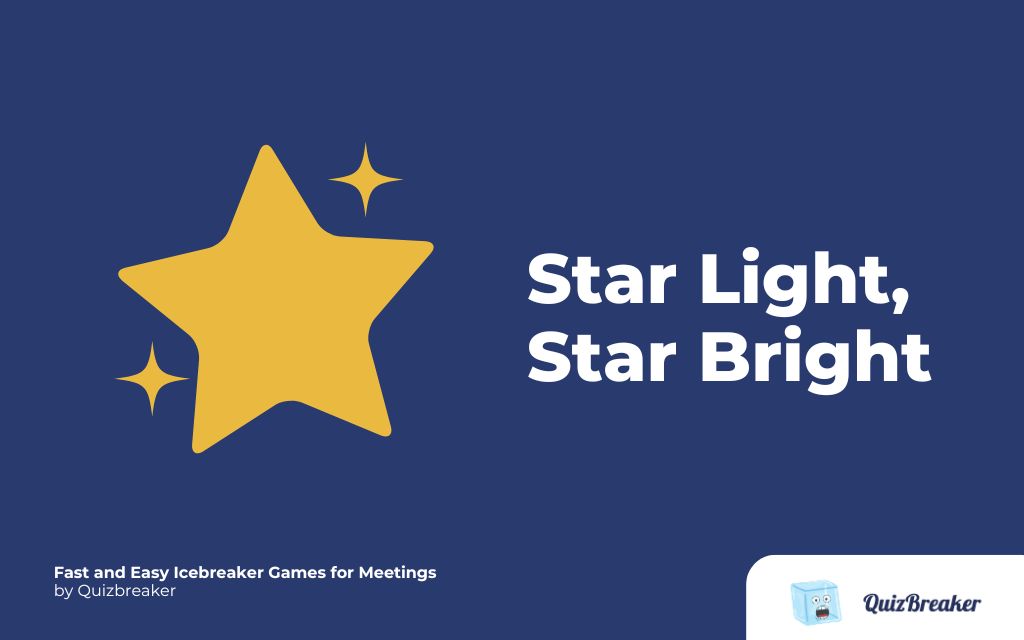
Objective: To develop trust by getting everyone to share their wishes for the team
Participants: 6 to 18 people
Duration: 6 to 8 minutes
Difficulty: Medium
Materials: Some stars (either buy them or do a spot of arts and crafts!)
We like this icebreaker because it encourages people to think about the possibilities, rather than the impossibilities.
This type of positive attitude and creative thinking drives successful teams.
Instructions
-
Ask your team members whether they have heard the poem “Star light, star bright, first star I see tonight; I wish I may, I wish I might, Have the wish I wish tonight”.
-
Encourage everyone to think of a wish that they have for the team.
-
Pass out the start shaped paper and get everyone to write down their wish for the team.
-
Get your team to stand in a circle and explain that the floor now represents the sky.
-
Repeat the starlight rhyme. Then, one by one, team members should place their stars on the floor and state what they mean.
5. Simon Sez
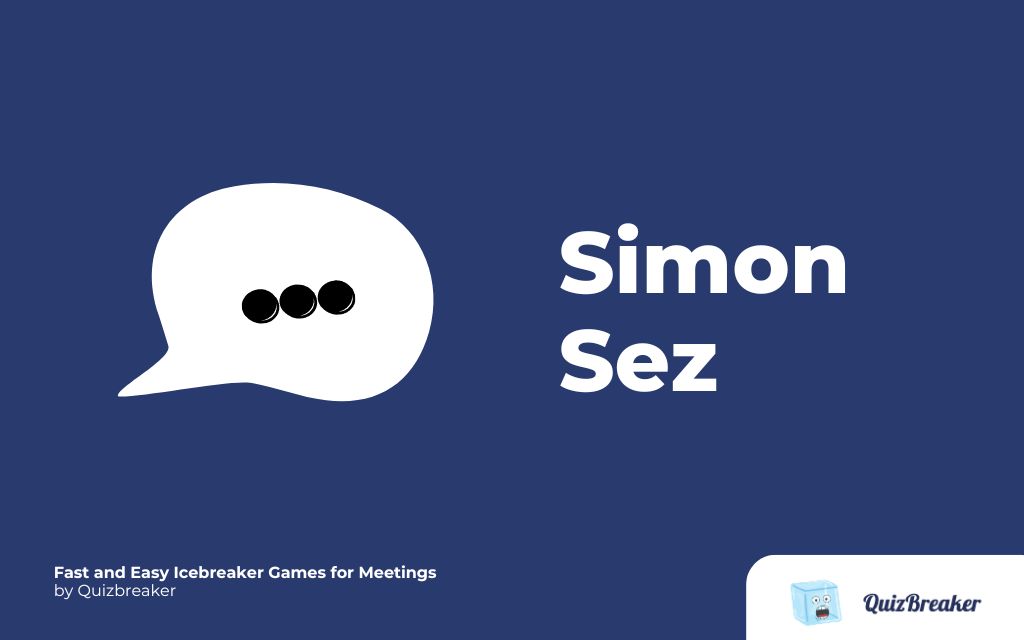
Objective: To get team members to find out their similarities and differences based on their birthing order
Participants: 10 to 200 people
Duration: 5 minutes
Difficulty: Medium to High
Materials: None
This is a well known activity that we used to play as kids but who says we can't still play it as adults?
We love it because it gets attention, creates energy and laughter, and gains the participation of everyone.
We recommend using this in a speech at the start of the meeting, or as a break during a lengthy, and sometimes boring, meeting.
Instructions
-
Get your teams to stand up and get ready to play Simon Sez.
-
Explain the simple rules: When you say “Simon sez” followed by an order, the group should obey the order; when you give an order saying “Simon sez”, they should not follow the order.
-
Give the orders. After each order, tell people who were correct in following the orders to remain standing and people who were wrong to sit down.
-
When finished, announce that the people still standing are the winners.
This is the Simon Sez order:
-
Simon sez lift your right hand into the air
-
Simon sez lift your left hand into the air
-
Put your right hand down
-
Simon sez put your left hand down
-
Simon sez point upward with your right hand
-
Simon sez point downward with your left hand
-
Simon sez point both hands toward yourself
-
Point both hands towards your neighbors
-
Simon sez stop point and sits down
-
Simon sez stand up
6. Birth Right
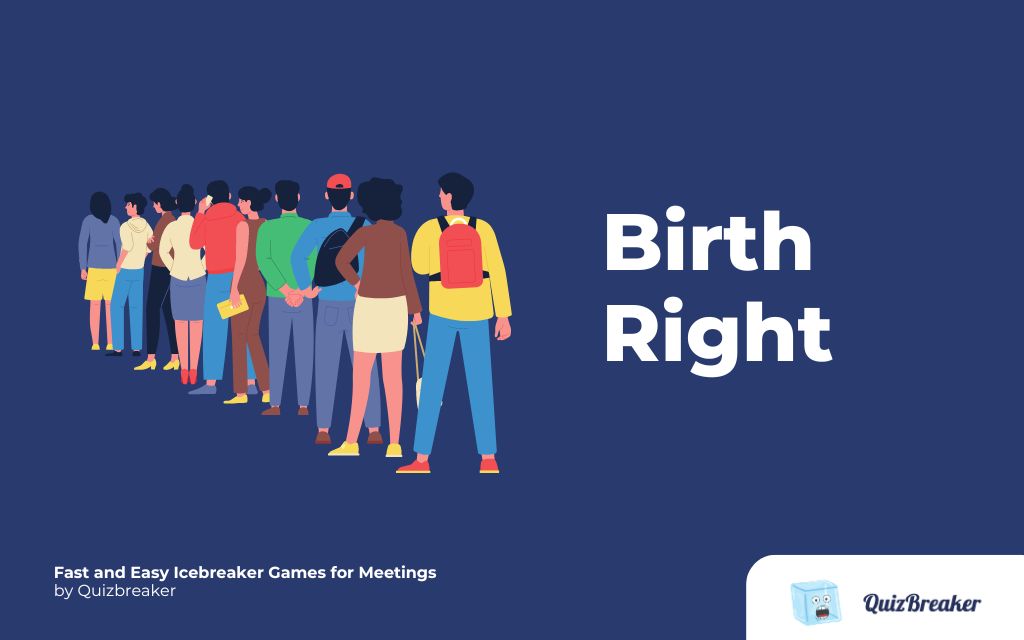
Objective: To get team members to find out their similarities and differences based on their birthing order
Participants: 15 to 50 people
Duration: 5 to 7 minutes
Difficulty: High
Materials: None
We recommend using this at the beginning of a session as a mixer, or after lunch as an energiser.
We love this icebreaker so much because it’s based on science - an abundance of research has, indeed, found that our birth order impacts us throughout our lives. It also gets team members to connect with each other on a personal level. Both old and new people in your team can get involved in this game.
Research has concluded our birth order affects our earnings, social attitudes, and sometimes even our academic performance.
Instructions
-
Explain to everyone that:
-
Birth order plays a role in our childhood development.
-
Common experiences and feelings are often shared by people of the same birth order.
-
This is an opportunity for them to discover those commonalities.
-
Ask participants to group themselves into the four corners of the meeting room by the following birth orders: oldest, middle, youngest and only child.
-
Participants have two minutes to answer and record their agreed-upon response to the following good icebreaker questions: what are the advantages of their birthing order, what are the disadvantages?
7. Double Take
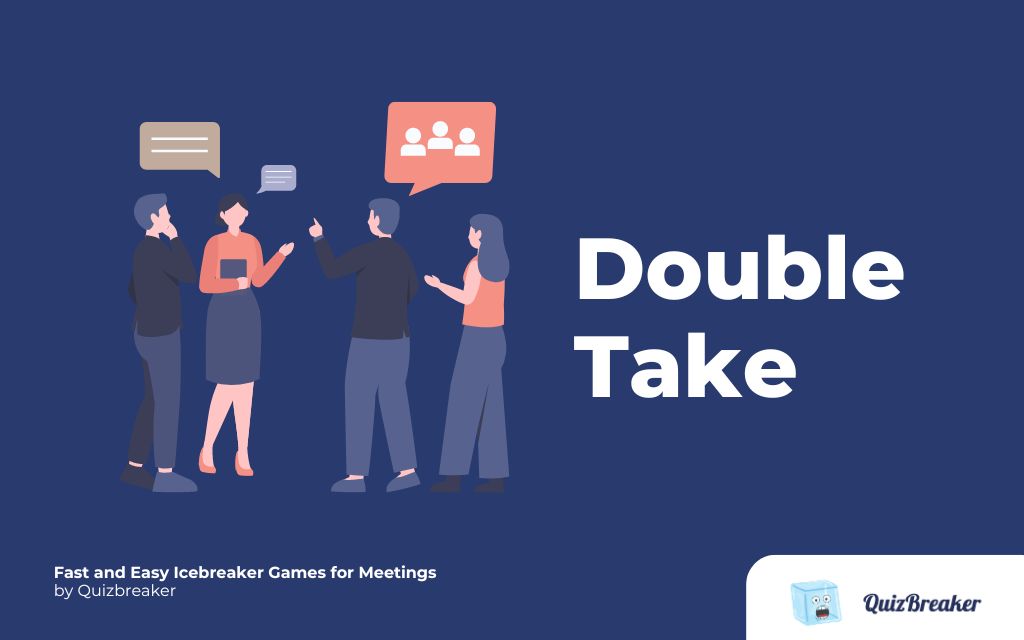
Objective: To get participants mingling with each other and exploring their common grounds
Participants: 20 to 500 people
Duration: 3 to 5 minutes
Difficulty: High
Materials: Upbeat music, a homemade activity sheet
We like double take because it allows participants to mingle, explore their common grounds and get to know each other. This game is a bit like People Bingo and we love it for all the same reasons!
Instructions
-
Ask participants to stand and move to a location in the room where they can walk around freely and mingle with others.
-
Play some music, and when the music begins, participants should begin shaking hands with each other and introducing themselves.
-
Call out characteristics that employees may have in common with each other (start off simple, with things such as hair colour or a number of kids), and then participants must immediately find another person who shares that particular characteristic.
-
Each time a new characteristic is called out, the employees should do a “double take” with a new person, whereby they match with them and get them to the activity sheet.
1. Tip: for the activity sheet, we recommend using the bingo cards suggested in the next chapter, or creating a simple list of characteristics in which your employees can jot down the name of the relevant coworker.
8. Great Shake
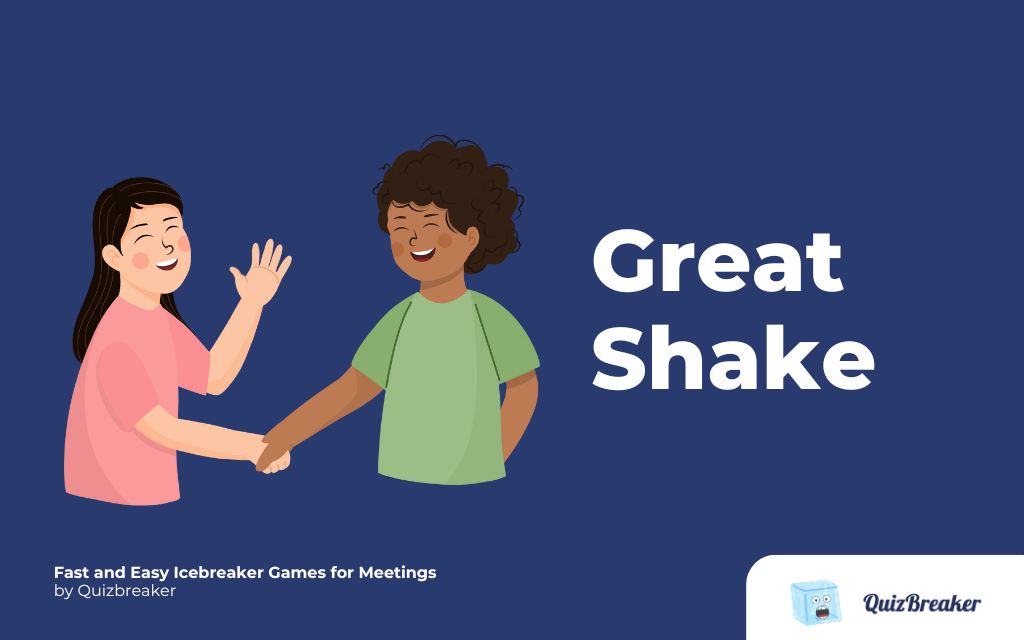
Objective: To get team members mingling by creating handshakes
Participants: 20 to 250 people
Duration: 2 to 4 minutes
Difficulty: High
Materials: Some great ideas for handshakes (found on the internet)
We love this activity because it gets employees moving around and shaking hands with each other.
We would recommend using it with employees who don’t know one another very well as it allows them to meet each other in a fun way.
Instructions
-
Get participants to pair up and practice types of handshakes with each other. We suggest trying these ones out, as they are easy and humorous.
-
After 5 minutes of practising, count to three and say “Great shake”. When you say great shake, the pairs must use one of the handshakes they learnt with their partner.
-
After they’ve done it, ask how many partners used the same shake.
-
Do this two or three more times.
9. Hand Jive
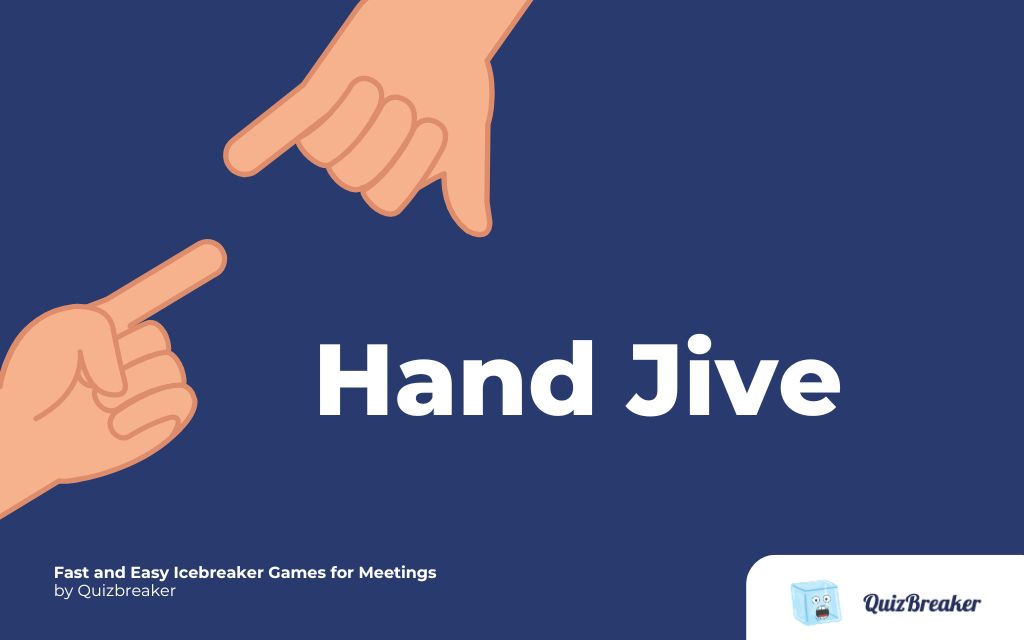
Objective: To get participants to form groups based on their hand position
Participants: 20 to 60 people
Duration: 8 to 10 minutes
Difficulty: Medium
Materials: Pictures of hands in four to six different positions (one position for each group you want to form)
We like this activity because it is playful, fun and light-hearted.
We recommend using it during the middle of a meeting as a way to get everyone up and moving about.
Instructions
-
Give each participant a picture of a hand in a certain position.
-
Explain to the group that their job is to find the other people in the group by looking for those who are holding their hands in the same position.
-
When groups have formed, tell them they have 5 minutes to create a sales slogan that somehow relates to their group's hand position.
-
After 5 minutes, ask each group to show its hand position and repeat its slogan.
10. Traffic Noise
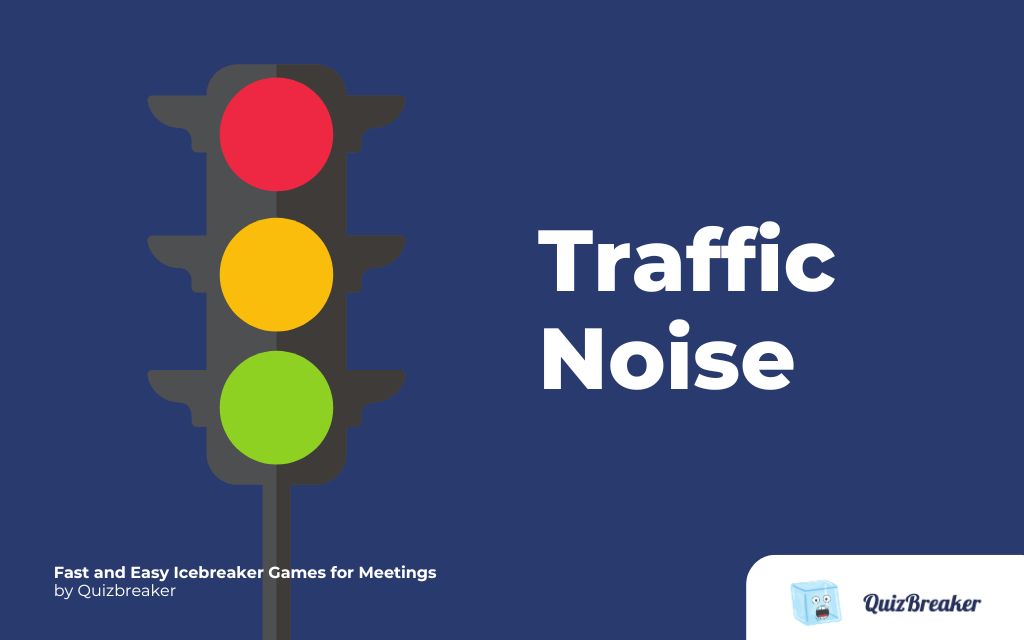
Objective: To get group members forming groups in a light-hearted and fun way
Participants: 18 to 40 people
Duration: 2 to 5 minutes
Difficulty: Medium
Materials: A picture of a few different vehicle’s (it depends on how many groups you want to form) and enough printed out to give to each participant
We adore this final game on our list because it is high-energy and offers a fun way to get people into groups and, communicate with each other, at any point during a session
Instructions
-
Give each participant a picture of a type of vehicle (the number of different vehicles you use should match the number of groups you wish you form).
-
Team members should group themselves by their vehicle’s sound - they should “drive through” the group, imitating the sound their vehicle makes.
-
When participants find other participants who are in the same vehicle as them (hopefully because they’ll be making similar sounds), they should join together, continue “driving around” and listen for other people who make the same noises as them.
-
When all participants are in their groups, ask each group to make its vehicle sound collectively for
the other groups to hear.
Here are Some More Icebreaker Games for Meetings to Try
Looking for more icebreaker games for meetings? Here are some other ideas you might want to try out with your team:
-
Two Truths and a Lie: Participants share two truths and one lie about themselves. The rest of the group tries to guess which statement is the false one.
-
Word Association: One person says a word, and the next participant responds with the first word that comes to mind, highlighting spontaneous connections.
-
Desert Island: Participants choose three items they would take if stranded on a desert island, explaining the reasons for their choices.
-
Story Chain: Someone starts a story with one sentence. Each subsequent participant continues, adding to the narrative, creating a collective story.
-
Bucket List Share: Members share an item from their personal bucket list, giving insight into their aspirations or dreams.
-
One Word Check-in: Each person describes their current mood or feeling in one word, offering a glimpse into their emotional state.
-
Birthplace Map: Using a map, participants mark their birthplaces, showcasing the group's geographical diversity.
-
Favorite Fictional Character: Discuss a beloved fictional character and provide reasons for the affinity, revealing personal tastes.
-
Job Swap: Participants express which job role they'd be curious to try within the company for one day and why.
-
Mystery Connections: Attempt to find an unexpected or unknown mutual connection or commonality with another person.
-
Quick Draw: In a short time, like 30 seconds, draw something related to the meeting's topic, promoting creativity and topic engagement.
-
Silent Line-Up: Without verbal communication, participants line up based on certain criteria, like birthdays or tenure.
-
Book Recommendations: Share a recently read book and a brief reason why it left an impression, promoting learning and sharing.
-
Hometown Share: Delve into a unique or intriguing fact about where you grew up, emphasizing individual backgrounds.
-
Rose, Thorn, Bud: Share a recent highlight (rose), a challenge (thorn), and something you're looking forward to (bud) in your life or work.
-
Inspiring Quote: Introduce a quote that motivates or resonates with you, and discuss why it's impactful.
-
Memory Share: Reflect on your earliest memory associated with the company or team, underscoring personal history and growth.
-
Office Poll: Conduct a light-hearted poll on a casual topic (e.g., favorite morning beverage) to engage and learn more about preferences.
-
Guess the Baby: Participants bring in their baby photos. Everyone tries to match the pictures with their colleagues.
-
Skill Swap: Describe a unique skill or talent you possess. Others can express interest in learning it, fostering a skill-sharing environment.
-
Funny GIF: Share a humorous GIF that encapsulates your past week, injecting humor and relatability into the meeting.
-
Dream Vacation: Paint a picture of your ideal getaway or vacation spot, offering insights into relaxation preferences.
-
Historical Dinner: Choose a historical figure you'd wish to have dinner with and explain the reasoning behind the choice.
-
Soundtrack of Life: Name a song that would be on the soundtrack of pivotal moments in your life, and discuss why.
-
Unique Object: Present a significant or quirky object from your life and share its backstory or why it's meaningful.
Frequently Asked Questions
What are the benefits of running icebreaker games before meetings?
Running icebreaker games before meetings can offer a multitude of benefits, including:
-
Ease Social Tensions: Especially in groups where participants may not know each other well, icebreakers can help reduce initial awkwardness and foster a more relaxed environment.
-
Boost Energy and Engagement: Icebreakers can serve as an energetic kickoff, especially useful for early morning or post-lunch meetings when energy might be low.
-
Encourage Participation: By getting everyone involved from the outset, individuals may feel more engaged and willing to participate throughout the meeting.
-
Build Team Cohesion: Icebreakers can promote a sense of unity and collaboration. Participants often see each other in a new light and appreciate diverse perspectives.
-
Facilitate Networking: In larger organizations or conferences, icebreakers can serve as structured opportunities for individuals to get to know colleagues they might not work with directly.
-
Reveal Information: Depending on the icebreaker, participants may learn more about each other's skills, backgrounds, experiences, or perspectives, which can be valuable for collaboration.
-
Set a Positive Tone: Starting with a fun or collaborative activity can set a constructive and positive tone for the remainder of the meeting.
-
Enhance Creativity: Many icebreakers require creative thinking. This can help prime participants for brainstorming or problem-solving sessions that follow.
-
Reinforce Meeting Objectives: Customized icebreakers related to the meeting's topic can help highlight and reinforce the session's goals or themes.
-
Increase Retention: A fun or engaging beginning can make the meeting more memorable. As a result, participants might retain more information from the session.
-
Improve Communication: Icebreakers that require effective communication can help teams refine their communication skills, essential for productive meetings.
-
Break Down Hierarchies: Icebreakers often place all participants on equal footing, regardless of rank or tenure. This can promote open communication and flatten perceived hierarchies.
Icebreaker games can transform the dynamics of a meeting, making it more productive, engaging, and enjoyable. They serve not only as a means to "break the ice" but also to create an environment where participants feel valued, heard, and ready to contribute.
What are some fun ways to start a virtual meeting?
-
One fun way to start online meetings is to start off with a few fun ice breaker games. Any of the ones from our list will be perfect!
-
Simply ask each other icebreakeer questions to get the meeting started. You can make your own questions of use our free icebreaker generator.
-
Start at a different time of day, it will be a great way to break a monotonous day.
How do you run an engaging virtual meeting?
Be clear on your team's agenda and create expectations. Send your meeting agenda ahead of time so your employees can be prepared to ask questions. Check-in with every ask, "how they are doing?" and have time for a bit of small talk.
Conclusion
We hope you've liked our list of the best ice breakers for meetings.
Other self explanatory activities you can consider are 'two truth's one lie', 'the best way to get out of bed', 'one word for 2020', 'one thing I'd never eat' or a 'virtual scavenger hunt'.
Try these out and let me know how you go.


